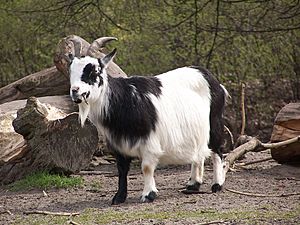Astor markhor facts for kids

The astor markhor or flare-horned markhor (Capra falconeri falconeri) is a special type of wild goat. It's known for its amazing spiral horns! This animal lives in the high mountains of Kashmir and northern Pakistan. Sadly, it is an endangered species, which means there are not many left in the wild.
Contents
All About the Astor Markhor
The astor markhor is a subspecies of the markhor, a large wild goat. Its scientific name, Capra falconeri falconeri, helps scientists identify it. These animals are famous for their unique, corkscrew-shaped horns. The males have much larger and more impressive horns than the females.
What Do Astor Markhors Look Like?
Astor markhors are strong, agile animals. They have a shaggy coat that can be reddish-brown or grayish. Their most striking feature is their horns. These horns grow in a tight spiral, twisting upwards like a flare. Males can have horns that reach over a meter long! Females have smaller, less twisted horns.
Where Do Astor Markhors Live?
These incredible goats are native to specific mountain regions. You can find them in the rugged, rocky areas of Kashmir. They also live in the northern parts of Pakistan. They prefer steep, forested slopes and rocky cliffs. These places offer them protection and food.
Why Are Astor Markhors Endangered?
Being an endangered species means their numbers are very low. There are several reasons why astor markhors are in danger. One big problem is habitat loss. Their mountain homes are shrinking due to human activities. Another challenge is illegal hunting, which has reduced their populations.
How Can We Help Astor Markhors?
Many people and organizations are working to protect the astor markhor. Conservation efforts focus on preserving their natural habitat. They also work to stop illegal hunting. Creating protected areas helps these animals live safely. Educating local communities is also important. By learning about these animals, people can help protect them. Every effort helps ensure the astor markhor can thrive for future generations.

